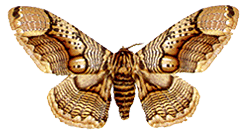|
Brahmaea hearseyi White
Brahmaea hearseyi White, 1862, Proc. ent. Soc. Lond., (3) 1: 26.
Brahmaea
whitei Butler, 1866, Proc. zool. Soc. Lond., 1866: 119.
|

Brahmaea hearseyi 
(.61 natural size)
|

|
Diagnosis. It would be impossible to confuse this species with any other.
Taxonomic notes. B. celebica Toxopeus stat. n., from
Sulawesi,
is here recognised as distinct. It is smaller, with fewer component fasciae in
the subbasal and submarginal zones of the forewing; the subapical pale sector of
the submarginal zone is not so strongly distinguished from the rest as in
hearseyi being significantly pale only at its posterior margins; this subapical
pale zone is basally convex as in hearseyi rather than concave as in wallichii,
but restricted to the dashes on the veins. In the male genitalia the valves have
merely denser sclerotisation distally on the sacculus rather than a distinct
lobe. B. hearseyi has a conspicuous invagination between the seventh and eighth
sternites that is lacking in celebica.
Geographical range. N.E. Himalaya, W. China, Burma, Sundaland (ssp ardjoeno
Kalis = luchli Dupont in Java), Philippines.
Habitat
preference. In Borneo the species has been taken infrequently in lowland
rainforest and up to 1000m on G. Mulu and 1200m on G. Kinabalu; in Sulawesi B.
celebica was encountered more in montane forests.
Biology. The larva was found by K.R.C. Tuck at Genting Tea Estate, W. Malaysia
and reared through to pupation. Middle instars had the head, filaments, true
legs and prolegs black, the venter reddish; each segment is ringed anteriorly
with black, and is laterally, below the spiracles, broadly bright yellow (this
yellow extends completely over the dorsum on the thorax). The abdominal dorsum
is whitish with two black patches on either side. The final instar, from which
the filaments are lost, has the upper surface bright yellow, ringed and marked
with white. On each segment the spiracles occur in a broken black triangle that
expands towards the anterior; below this triangle are stripes of orange-yellow
and pink. The venter is greenish white; the prolegs are ringed black and
greenish white.
When threatened, the larva erects its anterior half and tucks in its head,
presenting to the attacker the thoracic dorsum with filaments or (in the final
instar) eye-spots.
The host-plant in the wild was not identified. The larva was reared on Ligustrum
(Oleaceae) in the U.K. These descriptions are based on colour transparencies in
the BMNH.
<<Back
<<Return to Contents page
|

